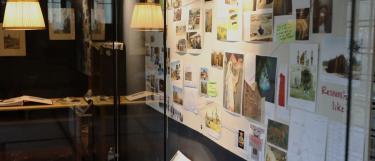
Photography Exhibition in the Völkerkundemuseum: REFLECTIONS of the ARCHIVE
Students from the Heidelberg Centre for Transcultural Studies develop an experimental presentation using photographs from the museum’s photo archive
What questions and insights can be formulated today using photographic material from different eras and regions? How have the actors, the meaning and the materiality of photography changed over time? An experimental exhibition – on display at the museum from 11 February 2024 – will focus on selected photographs from the archive of the Völkerkundemuseum vPST. The presentation titled “REFLECTIONS of the ARCHIVE” was created as part of a course at Heidelberg University and developed by students at the Heidelberg Centre for Transcultural Studies (HCTS). It can be viewed in the Völkerkundemuseum vPST until 6 October.

“Working with a photo archive shows that the acts of taking, archiving and viewing photographs are not only shaped by the actors involved, but also by historical contexts and contemporary interpretations,” explains Prof. Dr Christiane Brosius, who teaches and researches at the HCTS. The researcher initiated the exhibition alongside associate professor and fellow HCTS member Dr Carsten Wergin and the Director of the Völkerkundemuseum vPST, Dr Alban von Stockhausen. Under their leadership, the students explored the question of how the photo archive in a museum can be digitally recorded, documented and used as a resource for research and exhibition activities. Using selected photographs from the museum archive, they critically examined the origins of the photos, as well as the interpretations of the content and the use of the images. Various photographic media are shown – from glass plates and photo albums to individual images from the 20th century to the present day.
In eight stations, the exhibition “REFLECTIONS of the ARCHIVE” approaches the individual encounters of the exhibition curators with the photographic material. The students’ immediate reactions to the images served as the starting point for their research-based curatorial work. As part of this experimental approach, visitors are also invited to reflect on their interpretations of the images and to consider why they may differ from the positions of the curators.
The Völkerkundemuseum vPST at Heidelberg University dates back to 1921. The museum’s collections include more than 40,000 works of art and ethnographic objects from Asia, Africa and Oceania, as well as historical photographs, manuscripts and objects of natural history. Both the museum and the J. u. E. von Portheim Foundation for Science and Art are based in the Palais Weimar in Heidelberg’s old town. Not only do the substantial collections and archives form the basis for the museum’s exhibitions and educational offerings – they also serve as the foundation for the work of researchers from all over the world.